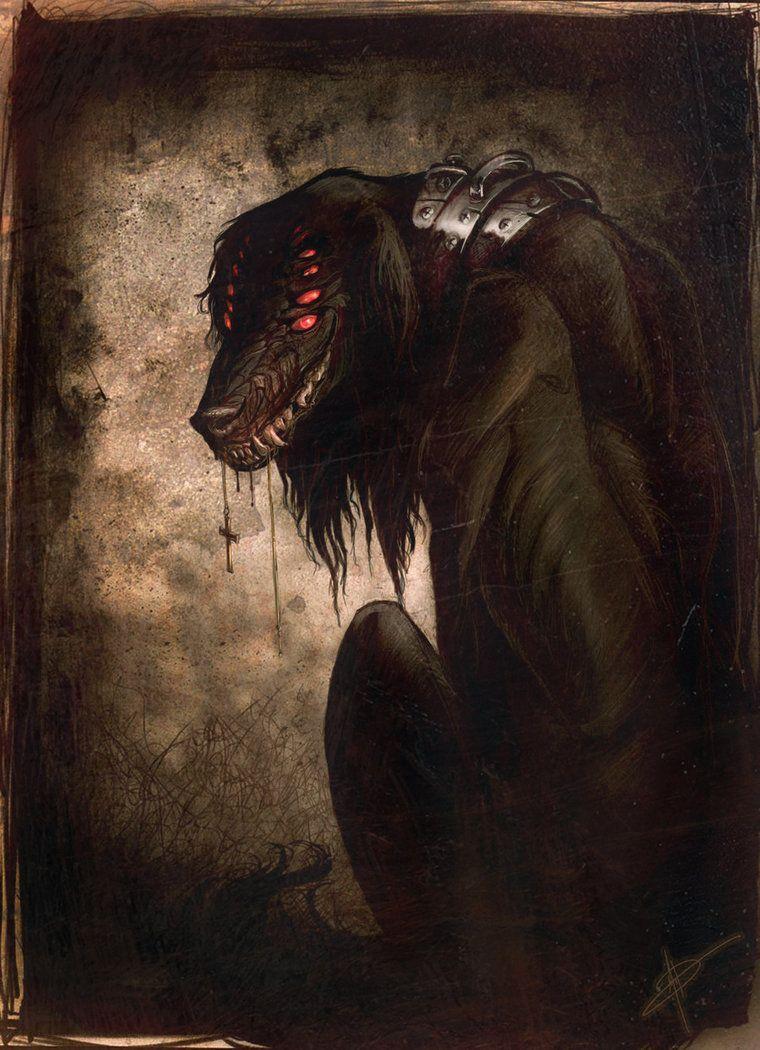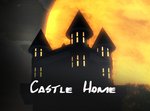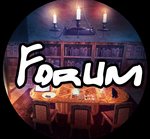Hellhounds in Mythology
2 posters
Page 1 of 1
 Hellhounds in Mythology
Hellhounds in Mythology

Original Article
If you’re traveling through the countryside at night, a whiff of brimstone or a blood-chilling howl can alert you to the presence of a Hellhound—but we don’t recommend that you look around for the beast. As soon as you lay eyes on one of these dark specters, your days are numbered; you will soon die.
What is a Hellhound?
A Hellhound is a monstrous dog, leashed to the spiritual world. Nicknamed “Bearer of Death” in some parts of the world, they can often be found guarding the entryways to the afterlife or skulking in the shadows behind a person who is doomed to die soon.
Characteristics
Physical Description
The Hellhound’s appearance varies from region to region, but wherever they pop up, they strike fear into the hearts of witnesses.
These phantom canines are considerably larger than a normal dog. A small Hellhound is about the size of a mastiff, while a large one can dwarf horses and bears. Their hair is black as coal, and their eyes glow like angry red or green flames. The most terrifying individuals may have multiple heads or, eerier still, have no head at all.
Spotting a Hellhound can be difficult, since they are mostly nocturnal creatures, and their black hair blends in with the darkness of the night. Still, if you keep alert, you might smell a sulfurous odor as the beast gets closer, or you might notice a trail of scorched ground where his path crosses yours.
Personality
Despite their ferocious appearance, most Hellhounds are more mysterious than hostile. They rarely attack humans unless they are provoked. In fact, even if you wanted to fight one of these monsters (unlikely), it would probably run away or disappear into the mist or shadows before you had time to launch an attack.
In some stories, Hellhounds are valiant and devoted guardians. They might be assigned to guard a treasure or sacred ground, in which case they will spend an eternity glowering over their charge. Again, the beasts will only attack if they are provoked—but if you put one toe too close to their treasure, it might be the last move you ever make. Unlike their free cousins, a guardian Hellhound will never back down or run away from a fight.
In a few rare cases, Hellhounds have been seen escorting women through the night or escorting souls on their way to the afterlife, to protect them from other monsters that might be lurking in the dark. These accounts seem to show that the canines are soft-hearted and benevolent. However, other rare cases have documented the hounds attacking churches or other religious gatherings, which paints them in a nastier light.
Special Abilities
The hounds have many supernatural skills that make them both powerful allies and fearsome enemies. To begin with, they have incredible speed and strength, even for large predatory animals like themselves. They can outstrip a cheetah in a race and rip down trees with their claws. They are also masters of disguise, able to conjure up cloaks of mist, shapeshift into various forms, or even vanish into thin air.
In cultures that associate fire with hell, the hounds are also able to play tricks with flames. They scorch the ground where they walk, and their claws are as hot as flames when they lash out. They are brilliant at dramatic entrances and exits, conjuring up pillars of fire to transport themselves.
Overall, the Hellhound’s most dreadful ability is his uncanny sense for death. If you see a Hellhound, your odds of denying in the next year skyrocket. If you see him three times, you are definitely a goner. It is unclear whether these black specters appear merely as omens of death or if seeing them actually causes death. Either way, they are not a welcome sight!
Cultural Representation
Greek Mythology
According to ancient Greek mythology, Hades, the god of the underworld, kept a monstrous Hellhound named Cerberus at the mouth of the underworld to prevent dead souls from escaping back into the world above. Cerberus, had three heads, with ferocious jaws and eyes, and the tail of a snake. At one point in history, he was captured by Heracles and removed from the underworld, which caused him so much distress (possibly because he was anxious about abandoning his post as a guardian and possibly because he was unused to sunlight) that he vomited poison and howled with grief. Eventually, he was returned to his home.
Eastern Folklore
In China, a huge black demon-dog, named Tiangou, is blamed for causing eclipses by eating the sun or the moon. In Japan, a wolf-like demon, called Okuri-inu, is said to follow men and women who travel by night. If the traveler has a worthy heart, the Okuri-inu will protect him from other monsters. If, however, the traveler displays cowardice or clumsiness (usually by tripping or falling), the hound will devour him.
English Folklore
England is haunted by more Hellhounds than any other country. From bustling coastal towns to lonely estates on the moor, each region has its own incarnation of the hound.
The Barghest belongs to the Yorkshire area in northern England. He is noted for his talent as a shapeshifter, frequently appearing as a headless woman or a white cat or rabbit, as well as the traditional black dog. He is also less shy than other Hellhounds, and he is quite comfortable loping into a town square.
Black Shuck belongs to the coastal areas of Norfolk, Essex, and Suffolk. He is distinguish by an unusual physical trait: he has only one eye, glowing in the center of his forehead. Generally Black Shuck is one of the gentlest Hellhounds, choosing to spend his time protecting women and young girls when they have to travel at night. However, in the sixteenth century, he made an infamous attack on two churches, killing two people and causing the steeple to fall through the roof.
The Cŵn Annwn belongs to Wales. Unlike other Hellhounds, who generally travel alone, the Cŵn Annwn travels with a collection of other supernatural characters called the Wild Hunt. When they aren’t joining in the sport of the Wild Hunt, they spend their time guiding lost souls to the Otherworld, a paradise that can be reached after death.
The Yeth Hound belongs to Devon. Like some other Bearers of Death, this hound is headless. He rarely interacts with humans, but his wailing cry can be heard by night travelers and is frequently interpreted as an omen of death.
The Black Dog of Bouley belongs to England’s channel islands. It is the fastest of all Hellhounds, and it likes to terrify travelers by galloping in circles around them. Sometimes, this monstrous beast can run so fast that it actually creates a storm. The hound is known to wear a broken chain draped around its body, but no explanation of this chain has been given.
Scandinavian Folklore
In early Norse culture, the god Odin was said to be accompanied by one or two monstrous wolves, who helped protect him from danger. In one epic poem, Odin rides to Hel, the Viking underworld, and encounters a “hound” there who may be guarding the entryway. It’s believed that Odin’s wolves or these hounds may have inspired many of England’s stories about Hellhounds.
Long after the Vikings had passed into the pages of history, Scandinavia continued to be haunted by “church grims.” These spectral black dogs guard the churches where they live, protecting it from evil spirits who might try to invade the sacred ground.
Native American Folklore
The indigenous people of Mexico and Central America have many legends about the Cadejo, a spirit dog that is often seen by travelers, especially at night. Cadejos come in two colors, white and black. The white spirits are benevolent and will protect travelers from harm, but the black spirits are evil and will kill travelers if they have the chance. Both versions of this hound have goat hooves and sometimes horns. They also have a unique gift: they can speak with humans. However, if you listen to them, you will probably go insane.
Modern Incarnations
The Hellhound is an enormously popular character in today’s fantasy stories. He has appeared in some of the bestselling books of our time: The Hound of Baskervilles, by Arthur Conan Doyle, Percy Jackson, by Rick Riordan, Good Omens, by Neil Gaiman and Terry Pratchet, and Harry Potter, by JK Rowling. He is also a popular character in video games, including Call of Duty and Final Fantasy.
Most fantasy writers stick closely to the traditional legends about hellhounds; after all, this mysterious and complex creature gives them plenty of raw material to work with!

Silver Black- Owner

- Kin/Therio type : Naerubie ( celestial wolf guardian )
Age : 33
Job/hobbies : Comission Artist, Gamer, Singer, working at my own terms.
Join date : 2016-06-24
Your Kin self Information Sheet
Name of your kin self : : Silver Black
What is your kin type ? : Naerubie ( Interdimensional Angel Wolf being )
Describe it Physically : : winged wolf with avian features -

 Re: Hellhounds in Mythology
Re: Hellhounds in Mythology
I have a spiritual hellhound that's usually around me from the Infernal and another one from the Norse pantheon. The Norse one is kind of scary, but the Infernal one is adorable, he looks kind of like a german pinscher and the creepiest ability they have is to scare off predators, they can make their flesh vibrate and move, however, some have scales, some have fur, some are bald, and some have feathers, they can grow to be pretty big but as puppies they're just the cutest things and make great protectors!

Liudan- Kin/Therio type : Divinekin
Job/hobbies : Energy work and ESP
Join date : 2016-06-28
Your Kin self Information Sheet
Name of your kin self : : Nature
What is your kin type ? :
Describe it Physically : :
 Re: Hellhounds in Mythology
Re: Hellhounds in Mythology
Hi Liudan, can you tell us more about your hellhounds and hellhounds in general? You seem to know a lot about them!
Guest- Guest
 Re: Hellhounds in Mythology
Re: Hellhounds in Mythology
Hellhounds are pretty much similar to dogs here, they’re bred for companionship, hunting, and so forth, even sold and given as mine was a gift from my old mentor. Infernal hellhounds differ from Helheim hellhounds as the hellhounds from helheim are more jotun in nature than the hellhounds of the infernal. Mine is a boy who my old mentor had mate with his scaled female one and I got to keep the babies as well. They eat meat or usually hunt for it themselves in the etheric. Although as a baby/pup they need assistance and tend to be in the energetic layer with you from time to time. When you bond with one you both develop a mark on one another that shows that bond.

Liudan- Kin/Therio type : Divinekin
Job/hobbies : Energy work and ESP
Join date : 2016-06-28
Your Kin self Information Sheet
Name of your kin self : : Nature
What is your kin type ? :
Describe it Physically : :
Page 1 of 1
Permissions in this forum:
You cannot reply to topics in this forum







